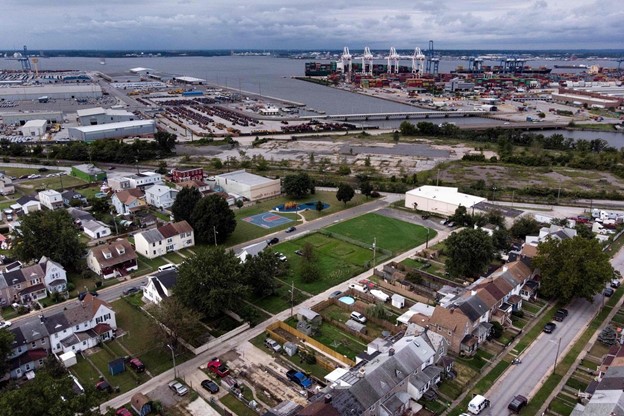
A neighborhood of Baltimore, Sept. 21, 2018. PHOTO: BRENDAN SMIALOWSKI/AGENCE FRANCE-PRESSE/GETTY IMAGES
Why Struggling Cities Should Cut Property Taxes
Originally published in the Wall Street Journal
It’s the perfect time to reboot urban economies and help the country’s poorest homeowners.
As the pandemic recedes, cities and towns are feeling the budget pinch. Many will be tempted to raise property taxes to fill the gaps. They should cut them instead. This isn’t only sound economics—it’s also an antidote to a regressive taxation scheme whose costs fall unfairly on the country’s poorest homeowners, many of them minority residents of struggling cities.
The traditional case against high property tax rates is that they deter investment, chase people out of cities, and make it harder to attract new residents. Growing empirical evidence from across the country shows that property taxes are also inequitable, saddling low-income homeowners with a lopsided share of municipal tax burdens.
On the surface, it isn’t intuitive why property taxes are unfair. They are calculated, after all, as a fixed percentage of a home’s assessed value. The problem is that houses in poor neighborhoods generally sell for less than the assessment values used to calculate their property taxes, while expensive homes in affluent communities reliably sell for more than their assessed values. Tax assessors systematically undervalue America’s priciest homes and consistently overvalue the country’s least expensive homes. Affluent homeowners may be paying less in taxes than they should, and poorer homeowners have been paying more than they should.
Take Baltimore. According to data from a recent University of Chicago study, more than 75% of the city’s least valuable homes sold between 2007 and 2018 yielded prices that were lower than the assessment value used for property taxes. The exact opposite is true when it comes to Baltimore’s most lavish homes. During that same period those residences sold on average for more than twice the value used to compute property taxes.
This absurdity is amplified by Baltimore’s high property tax rate, which is twice that of neighboring counties, even as the city hemorrhages people. Baltimore has fewer residents in 2020 than it had in 1920. In return for paying the highest property taxes in the state, city dwellers get a stew of the worst services and outcomes in the U.S.: Municipal ineptitude leading to uncollected water bills, potholes pockmarking every other street, alleys strewn with trash. Many of Baltimore’s public school buildings lack heat or drinkable water, and the city’s homicide, drug-overdose, illiteracy and lead-poisoning rates are among the highest in America.
What an injustice that the residents most directly affected by this dysfunction are often the same homeowners who, because of inflated assessments, pay a higher share of the city’s property taxes. Baltimore isn’t alone in this regard. The same cruel irony persists in Detroit, Atlanta, St. Louis and other cities caught in the quicksand of exorbitant taxes.
Because of the myopia caused by the current crisis, leaders in cities like Baltimore may be unwilling to cut taxes. To reverse decades of decline and inequity, however, this is exactly what they must do. And they need to start now because U.S. cities are about to enter a fierce contest for capital as the economy emerges from pandemic-related strictures. How we work and where we live will never be the same, and unrivaled investments will accompany this transformation. Relief dollars from Washington will be dwarfed by pent-up private capital spilling into markets as American consumers begin to spend money again. This could be the biggest infusion of federal capital into the economy since the New Deal and the largest introduction of private investment ever.
Those investments won’t be distributed evenly, however, and cities will need to set themselves apart, conspicuously and fast. In the scramble to grab a share of this gold rush, there’s no time to lose. Cities should pledge to cut property taxes immediately because investment decisions are being made now.
The economic upside of cutting property taxes is evident in the academic literature. A 1999 school-finance reform in New Hampshire resulted in property-tax cuts across the Granite State. In low-density areas, economists found an 11% to 22% jump in residential construction; in southern New Hampshire, where housing concentration was already high, tax cuts drove up home prices instead. Both results—a surge in construction and higher home values—materialized in Boston and San Francisco too. Many forget that before they were two of America’s darling coastal cities, both were in steep decline, with substantial population loss between 1950 and 1980. Critical to their turnaround were statewide ballot measures in California (1978) and Massachusetts (1980), which slashed taxes. San Francisco’s property-tax rate plunged 57% practically overnight. Over the course of two years, Boston’s property-tax rate fell 75%.
These are lessons with renewed importance today. A modern cataclysm sparked by disease could give way to a renaissance of smart and righteous reform. In cutting property taxes, cities have a chance to reboot their economies and dismantle hidebound tax policies that have hurt poor homeowners the most. Leaders who seize this moment will see their cities surge ahead. Those who don’t will fall further behind.
Mr. Vignarajah, a fellow with the Institute for Corporate Governance and Finance at New York University School of Law, previously served as deputy attorney general of Maryland. Mr. Vignarajah can be reached at Thiru.Vignarajah@us.dlapiper.com






